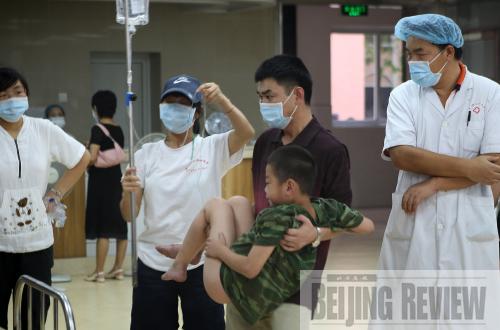|
 |
|
VULNERABLE GROUP: A feverish student receives treatment at Guangdong Province's No. 2 Worker Hospital. On July 13, 32 children attending a summer camp developed fevers. Fourteen were later confirmed to have the A/H1N1 virus (CFP) |
China's health authorities on July 13 altered their directives to diagnose and treat patients infected with the A/H1N1 flu. The change is the second after they altered the plans on May 8.
The revised version states patients with mild symptoms may receive treatment at home but community physicians must monitor for changes at least twice a day. Any differences in condition or temperature are to be reported to health departments.
The modified directive also lists infected persons showing no symptoms as the main source of infection for the first time. Researchers have found that 10 percent of those carrying the virus show no fever but are still infectious.
New measures
Early on July 8, the Ministry of Health (MOH) issued a notice adjusting A/H1N1 flu prevention and control measures, saying that people in close contact with flu patients will no longer be quarantined in reserved places but at home, while patients with mild symptoms may also receive treatment at home.
"The adjustment does not give up supervising close contacts. It's just a different place to quarantine people. They will still be restricted from going outside and making contact with other people," said Liang Wannian, Deputy Director of the MOH Emergency Office.
Those considered to be close contacts were also narrowed in the update. Close contacts include those who diagnosed, treated, nursed or visited a patient, those who worked or lived with a patient and people who had contact with a patient's bodily fluids. On aircraft, close contacts are now considered to be the eight passengers immediately surrounding a patient, the notice stated.
The directive gives provincial health departments the discretion to offer in-home quarantine and treatment.
Medical researchers now believe the virus is no more fatal than the seasonal flu and can be cured, said Liang.
"That doesn't mean we'll let go of the oversight and management of suspected cases as the virus is still spreading across the country," he said. "People will be quarantined in their own homes instead of the current designated places. The new measure will be more cost-effective and sustainable."
The new plan states that patients should live by themselves and use separate washrooms whenever possible when in home quarantine. They must also wear surgical masks when going out in public. Further, they must be quarantined at home for at least seven days. If they must leave home, such as to travel to a hospital, they must wear surgical masks.
| 